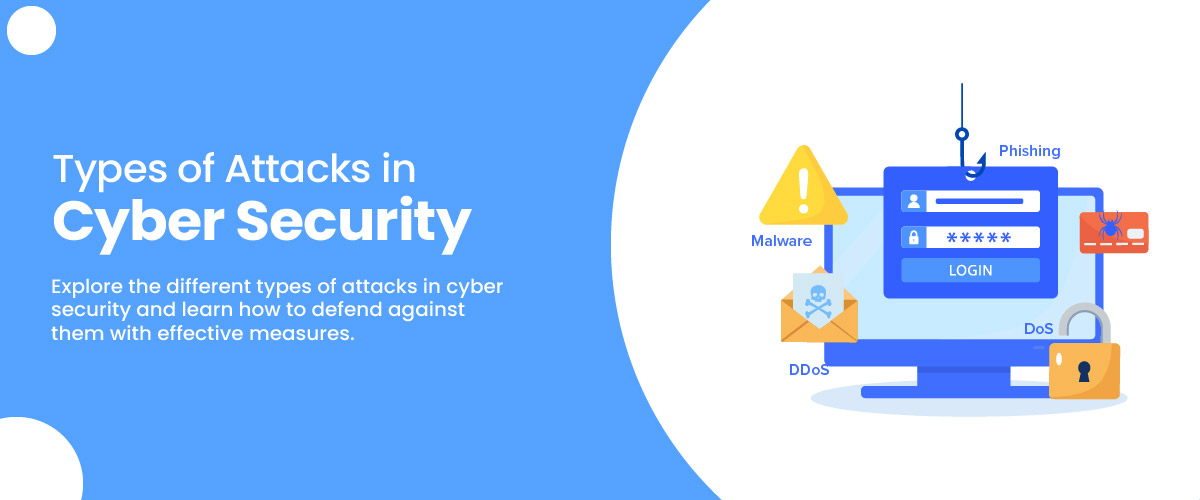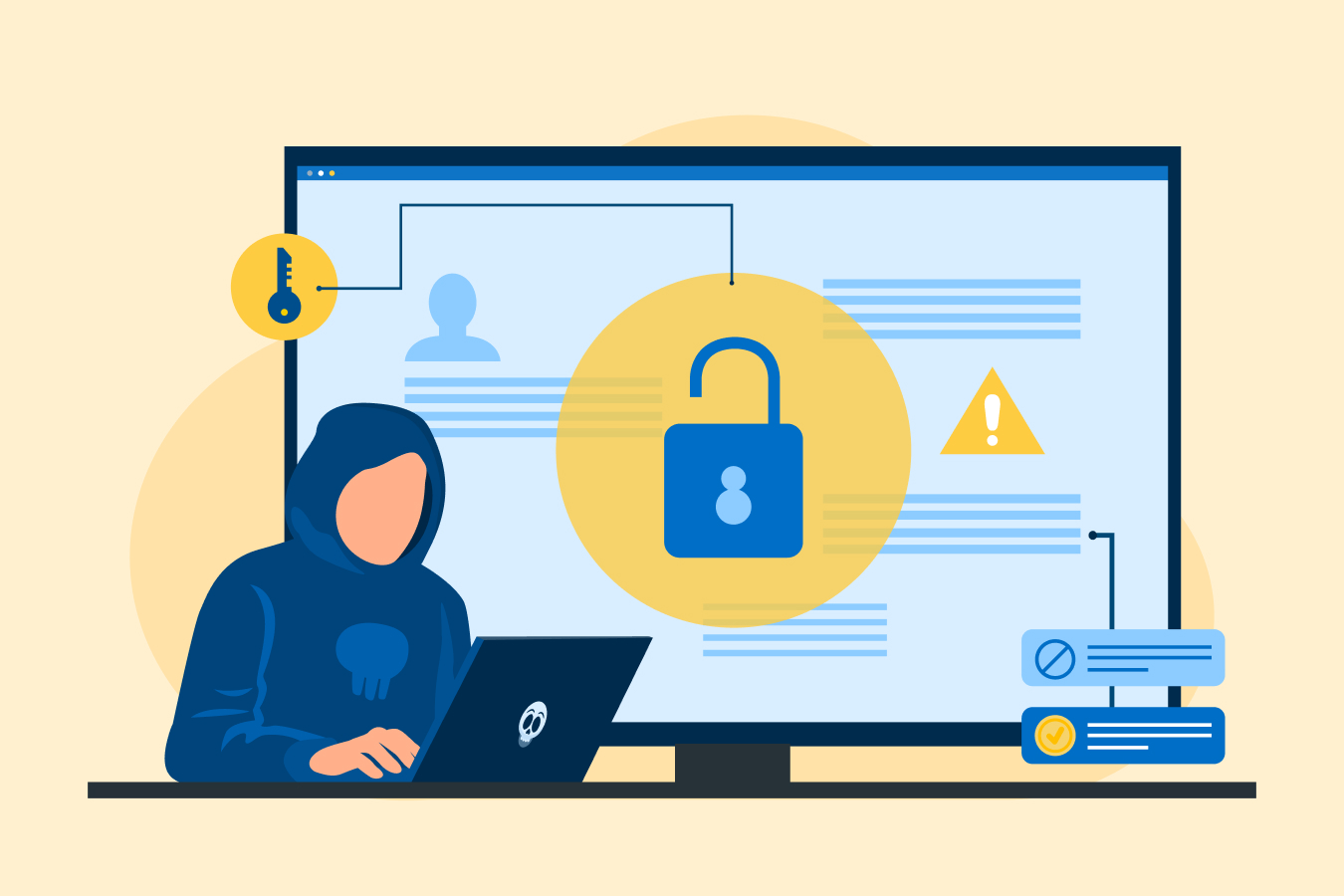15 Types of Cyber Attacks You Should Be Aware in 2025
As the world becomes more connected than ever, cyber threats continue to evolve at an alarming rate. Cyber security has become an essential part of our daily lives, affecting not only individuals but also corporations, governments, and other institutions. Understanding the most common types of cyber attacks and how they work is vital in recognizing and eliminating these threats. In this blog, we will delve into the world of cyber-attacks and discuss the fifteen most common types of attacks in cyber security that you may encounter.
What are Cyber Security Attacks?
Cyber security attacks are malicious attempts to infiltrate, steal, alter, or destroy digital information, infrastructure, or systems. These attacks can be carried out by a variety of actors, such as cybercriminals, nation-states, hacktivists, and even disgruntled employees. Cyber attacks can result in financial loss, reputational damage, and even physical harm in some cases, making cyber security an increasingly critical concern for individuals, businesses, and governments alike.
According to a report by Washington Post, in 2020, cyber security attacks caused an estimated $1 trillion in damages globally, reflecting the significant and growing impact of these malicious activities. As cyber threats continue to evolve and become more sophisticated, the potential for even greater financial and reputational damage in the future remains a pressing concern.
Also Read: Ethical Hacking vs Cyber security
15 Different Types of Cyber Attacks List
Here are the most common types of attacks in Cyber Security.
1. Malware
Malware encompasses malicious programs that target system infiltration, compromise, or destruction, such as viruses, worms, Trojans, ransomware, and spyware. The delivery methods of malware include email attachments, harmful links, or infected downloads. The effects of malware can range from pilfering confidential information and monitoring users to ransoming files.
Some measures to keep yourself safe from malware attacks are:
- Use an anti-virus software and keep it updated.
- Avoid clicking on suspicious links and do not download files from untrusted sources.
2. Spoofing
Spoofing involves attackers masquerading as other entities by altering communication origins. Methods used by cyber attackers include falsifying email addresses, manipulating IP addresses, and imitating websites to deceive their targets. These methods are often combined with other attacks (e.g., phishing) to deceive users into trusting attackers.
To prevent spoofing, follow the given steps.
- Enable multi-factor authentication for your accounts.
- Implement email authentication protocols, such as Sender Policy Framework (SPF) that will verify the authenticity of the email sender.
3. Phishing Attack
Phishing involves attackers impersonating legitimate sources through electronic means in order to coax users into providing sensitive data or clicking on malicious links. Another form of this is spear phishing. Spear phishing is a more focused form of phishing that targets specific individuals or organizations.
Follow the steps given below to prevent phishing.
- Make sure spam filters and phishing protection features are activated on your email or security software.
- Refrain from clicking on unexpected attachments or links, especially the ones from unknown emails and websites, asking for personal information.
4. Identity-Based Attacks
In identity-based strikes, cybercriminals leverage stolen or fake credentials to illicitly access target systems or data. This can include password theft, social engineering, or credential stuffing, where attackers use previously breached login details in automated attempts to access other accounts. Once inside a system, the attacker can perform malicious activities, such as data theft, tampering, or deploying malware.
Follow these steps to prevent identity-based cyber attacks.
- Avoid sharing credentials with others and use strong and unique passwords.
- Along with multi-factor authentication, regularly review activities to know about sign-in locations and devices.
5. Denial-of-Service (DoS) Attacks
DoS aims to incapacitate systems, networks, or services by flooding them, making them inaccessible. It is achieved by inundating targets with requests or data packets, leading to crashes or unresponsiveness. Distributed Denial-of-Service (DDoS) attacks involve multiple systems attacking one victim, intensifying the assault.
Follow these steps to prevent Denial-of-Service attacks.
- Use network monitoring tools to analyze and prevent traffic accordingly.
- Use DoS mitigation techniques, such as load balancers, firewalls, and intrusion prevention systems.
6. Code Injection Attacks
Code injection attacks involve inserting malicious code into a targeted system or application, usually via input fields or other data entry points. Once executed, the malicious code can compromise the system, allowing the attacker to steal data, deface web pages, or gain control of the target. Common types of code injection attacks, include SQL injection, cross-site scripting (XSS), and remote file inclusion (RFI).
Follow these steps to prevent code injection attacks.
- Make use of parameterized queries and prepared statements.
- Practice input validation exercises to ensure data is thoroughly validated before being processed.
7. Supply Chain Attacks
Supply chain attacks target software and hardware vendors, infiltrating their products or services before they reach the end user. This can include compromising source code, altering hardware components, or inserting malicious code into software updates. Supply chain attacks are particularly dangerous as they can bypass traditional security measures, giving attackers access to sensitive systems and data. The SolarWinds hack in 2020 is a prime example of a supply chain attack that had significant ramifications.
Follow these steps to prevent supply chain attacks.
- Through vendor risk management programs, evaluate security controls, certifications, and incident response capabilities of the suppliers, partners, and third-party vendors.
- Make sure you validate the authenticity of the software and codes acquired from third-party sources.
8. Insider Threats
Insider threats arise from within an organization and are perpetrated by employees, contractors, or other individuals with authorized access to sensitive information or systems. These attacks can be malicious, where the insider knowingly seeks to cause harm, or accidental, such as when an employee unwittingly exposes sensitive data or falls victim to phishing. Regardless of intent, insider threats can lead to significant damage, including data theft, system compromise, and financial loss.
Follow these steps to prevent insider threats.
- Regularly check the user activities, network, and system logs for any unauthorized access and behavior.
- Raise awareness among employees regarding the protection of sensitive data and recognizing signs of insider threats.
9. DNS Tunneling
DNS tunneling is a technique used by attackers to bypass network security measures by encapsulating non-DNS traffic within DNS protocols. This allows them to establish a covert communication channel with their target, often used for data exfiltration or remote command and control. DNS tunneling can be difficult to detect and is often used in advanced persistent threat (APT) campaigns.
Follow these steps to prevent DNS tunneling.
- Use DNS Security Extensions to validate the authenticity of DNS responses.
- Review DNS logs and analyze network traffic patterns regularly to identify suspicious DNS activities.
10. IoT-Based Attacks
The Internet of Things (IoT) comprises a vast array of interconnected devices, such as smart appliances, wearables, and sensors. These devices often lack robust security features, making them attractive targets for cybercriminals. IoT-based attacks can include hijacking devices for use in botnets, infiltrating networks via compromised devices, or using IoT devices to carry out other types of cyber attacks.
Follow these steps to prevent IoT-based attacks.
- Network segmentation and isolation will help separate and limit the communication of IoT devices with critical systems and data.
- Regularly apply security patches and disable unnecessary services and protocols. It will ensure IoT devices are securely configured.


11. Man-in-the-Middle (MitM) Attacks
MitM attacks occur when attackers secretly intercept communications between two parties, monitoring, altering, or stealing transmitted data. These attacks often take place on unsecured Wi-Fi networks or involve malware intercepting and modifying network traffic.
Follow these steps to prevent Man-in-the-Middle attacks.
- Use encryption technologies, such as Transport Layer Security (TLS) and Secure Sockets Layer (SSL). It will ensure secure communication between the client and the server.
- Implement proper network segmentation to minimize the impact of Man-in-the-Middle attacks.
12. Cryptojacking
Cryptojacking involves covertly exploiting a victim’s computing resources for cryptocurrency mining through malicious code in websites, apps, or systems. The consequences of crypto-jacking include higher energy expenses, reduced device performance, and possible hardware damage from overheating.
Follow these steps to prevent cryptojacking.
- Use endpoint protection solutions and anti-malware software to detect and block cryptojacking scripts.
- Use browser extensions and ad blockers to detect and block scripts used for crypto-jacking.
13. Watering Hole Attacks
Watering hole attacks entail cybercriminals compromising a website or online resource frequented by a target group to launch attacks on its members, such as malware installation or vulnerability exploitation. These attacks target specific organizations or industries.
Follow these steps to prevent watering hole attacks.
- Keep all the software, web browsers, plugins, and content management systems updated.
- Use reliable services to monitor the reputation and security status of websites that you frequently interact with.
14. Password Attacks
Password attacks are one of the most prevalent types of cyber attacks. It involves unauthorized account access by cracking or guessing passwords using methods like brute force (exhaustive combination testing), dictionary attacks (common password lists), or keylogging (capturing keystrokes).
Follow these steps to prevent password attacks.
- Set complex passwords using uppercase and lowercase letters, numbers, and special characters. Change the passwords frequently and avoid using the same passwords for all your accounts.
- Enable two-factor authentication that asks for a one-time password or biometric authentication, etc., in addition to the regular password.
15. Ransomware-as-a-Service (RaaS)
The RaaS model entails cybercriminals developing and selling ransomware tools/services to other criminals, enabling less skilled attackers to execute ransomware attacks without creating their malware or infrastructure. RaaS has amplified ransomware attack frequency and complexity, posing a growing threat to businesses and individuals.
Follow these steps to prevent Ransomware-as-a-Service cyber attacks.
- Back up your data regularly and store it offline or in a separate location.
- Use strong endpoint security solutions including antivirus, anti-malware, and behavior-based threat detection analysis to detect ransomware before it can encrypt the data files.
By staying informed about the latest threats and best practices, you can better protect yourself and your organization from the potentially devastating consequences of a cyber security attack. Remember, cyber security is a shared responsibility that requires the ongoing cooperation of all stakeholders to maintain a safe and secure digital environment. You can also learn more about cyber attacks and how to prevent them through an ethical hacking course.
Conclusion
Cyber Security attacks are an ever-present threat in today’s digital landscape. Understanding the various types of attacks in cyber security and how they function is critical in maintaining strong security and defending against these malicious activities. As technology continues to advance, new attack methods will inevitably emerge, making it crucial for individuals, businesses, and governments to remain vigilant and proactive in their cyber security efforts.
FAQs
The four types of attacks in network security are Phishing attacks, Denial-of-Service attacks, Man-in-the-Middle attacks, and Malware attacks.
Active cyber attacks leave noticeable traces when they disrupt, modify or manipulate the target system or network. They have a direct impact on the target. Passive cyber attacks, on the other hand, work secretly. They observe the target and gather information without altering or interfering with its normal operations.
There are a number of cyber attacks but about 15 are common. Keep in mind that new cyber attacks are discovered regularly with technological advancement and the list keeps increasing.
The two basic types of cyber attacks are active and passive cyber attacks.
The reasons behind cyber attacks could be personal grudges, financial gains, espionage, cyber vandalism and disruption, hacktivism, political reasons, and other criminal reasons.
Cyber attacks are a threat because they can lead to data theft and breaches, financial losses, disruption of operations, intellectual property theft, privacy violations, and even national security risks.
While we cannot completely stop the attacks, we can reduce their implications by taking proactive cybersecurity measures. Using and updating security software regularly, training personnel to deal with such issues, regular data back-ups, encryption, and staying updated on emerging threats can help us control these attacks.







